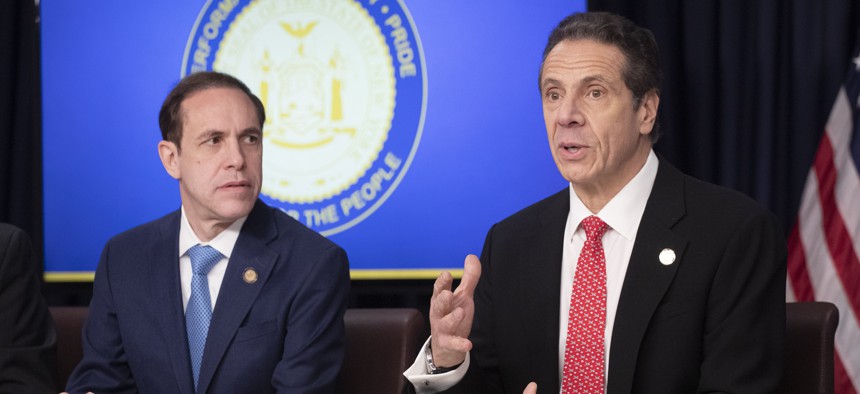Local Officials Say a Nursing Home Dumped Residents to Die at Hospitals

Dr. Howard Zucker, left, Commissioner of the New York State Department of Health, listens to Gov. Andrew Cuomo in March. Local officials have questioned whether New York's COVID statistics mask the number of nursing home residents who died. AP Photo
The deaths of 18 residents of a New York nursing home highlight the continuing controversy over the Cuomo administration’s decision not to count deaths in hospitals as nursing home deaths. The home denies the allegations.
The nurse with the Columbia County Health Department recorded the COVID-19 deaths at nearby hospitals—two at Albany Medical Center on May 4, another at the same hospital two days later; one at Columbia Memorial Hospital on May 17, and another there two days later—and, along with her boss, concluded there was a pattern.
The people dying at the hospitals had been residents of a local nursing home, the Grand Rehabilitation and Nursing at Barnwell in the tiny town of Valatie, New York. In all, the nurse counted 18 deaths of residents over five weeks. She didn’t have detailed medical records for the patients, but she noted that all had arrived at the hospital with orders saying no extraordinary measures were to be taken to keep them alive. As a result, she and the Columbia County health director developed a theory: “For me,” said Jack Mabb, the health director, “it appeared they were sending people to the hospital so they wouldn’t die in the facility.”
A change in the way New York tabulated nursing home deaths could have incentivized such behavior, he said, making homes’ records on COVID-19 containment appear better than they were.
In the early weeks of the pandemic, the state had counted these deaths by attributing them to the nursing home regardless of where they physically occurred. But in April—as the death toll related to nursing homes mushroomed, hitting as many as 250 deaths a day—that changed: The administration of Gov. Andrew Cuomo decided not to count residents who died of COVID-19 in hospitals as nursing home deaths, saying it feared that their deaths would be double-counted if they were recorded that way.
The administration insisted the move wasn’t meant to suppress the numbers at nursing homes, facilities Cuomo had reassured the public were his top priority for protecting from the pandemic. In public testimony this month, Howard Zucker, the state’s health commissioner, defended the decision and argued that New York had been as transparent about nursing home casualties as any state in the nation.
Today, more than 6,500 nursing home residents are known to have perished in New York facilities, some 6% of the state’s nursing home population. The state declined to say how many additional residents died in hospitals after being sickened in nursing homes.
Mabb said that his department’s nurse had sent reports about the deaths of Barnwell residents at local hospitals to state authorities, and that he had asked for an investigation. Some of the residents died soon after arriving at the hospitals, Mabb said, while others took longer to pass away. But the fact that all 18 had do-not-resuscitate orders or similar directives suggested to him that they had been sent to the hospitals with little hope of ever returning to the home. The department, Mabb said, shared its documenting of the deaths with the state.
“There are very few legitimate reasons for a nursing home to send seriously ill residents with do-not-resuscitate orders to a hospital unless there is a real chance that their conditions could be improved,” Mabb said. “We flagged it for the state. We told the Department of Health we thought something big was going on.”
Mabb said the state Health Department, which regulates nursing homes, has yet to tell him if it’s investigating what happened to the Barnwell residents.
Bruce Gendron, a vice president of the company that operates the Barnwell nursing home and 15 others, rejected Mabb’s claims that the home had sought to dump dying residents at local hospitals. He said that residents only would have been sent if they needed care beyond what the home could provide, and that those residents deserved every chance to survive.
Gendron said any scheme to inappropriately send residents to die elsewhere would have involved the home’s medical director and several of its nurses, all of whom are licensed by the state and would have been putting their careers at risk.
Twice in May, state Health Department investigators conducted “complaint surveys” at the Barnwell home after scores of staff members and residents at the home tested positive for COVID-19.
The Department of Health website shows that inspectors found problems with the facility’s ability to contain the virus: Uninfected residents were living alongside infected residents; residents suspected of having COVID-19 also were not separated. Some Barnwell staffers told the Health Department that they were confused about when they were supposed to wear masks and gloves or change out of old equipment and under what circumstances. The inspectors cited the facility and ordered a halt to additional admissions. Dozens of residents were eventually relocated.
Gendron first told ProPublica that the allegations of dumping dying residents at hospitals had been investigated by the state Health Department and found to be unsubstantiated. Asked to produce such a finding, Gendron referred to the inspections done in May, saying the absence of any findings related to hospital transfers proved the home had been cleared. Barnwell’s quality of care related to COVID-19 had become a public controversy in May, prompting coverage in the local media, and Gendron said he assumed the state would have been alert to any other problems at the home, including signs of dumping residents.
The state’s inspection reports make no mention of investigating hospital transfers. The Health Department did not respond to questions from ProPublica about whether it had investigated Mabb’s allegations. ProPublica shared Gendron’s version of events with the state, but again, the Health Department did not respond. Jill Montag, a department spokeswoman, appeared to be unaware of the allegations involving the home’s dying residents, asking ProPublica to send along a record of them.
There is little doubt that Barnwell, a 236-bed facility in the Hudson Valley, was overwhelmed by the virus this spring. From March 30 through the first week of June, according to county statistics, scores of staff members and residents tested positive for the virus.
But trying to unpack what exactly unfolded at Barnwell lays bare the confusing and often conflicting available information about COVID-19’s deadly path through the state’s elderly population.
The county Health Department is responsible for identifying cases of COVID-19, and nursing homes are obligated to report such cases to it. But nursing homes are regulated by the state, and the county has a limited ability to make sure such facilities are responsibly reporting and managing outbreaks.
Mabb said he had only received notifications from the Barnwell home on two deaths inside the facility. The state Health Department says online that the death toll from the home is 12. Mabb said he thought the first infection at Barnwell had involved a staff member; the state has said the first case of COVID-19 at the facility involved a resident, but it can’t say with certainty what role if any the resident played in the eventual outbreak.
Mabb said he has ultimately come to mistrust any information coming from either the state or officials with Barnwell. He said he counts the 18 deaths of Barnwell residents at the hospitals as nursing home deaths.
ProPublica contacted the three hospitals where Barnwell residents died, but none would talk about the deaths or the county’s allegation that residents had been sent to them to avoid being recorded as nursing home fatalities.
As Gendron pointed out, decisions to send nursing home residents to the hospital for additional care are supposed to be approved by a home’s medical director. He would not provide copies of such approvals involving the 18 residents who later died at hospitals, however, saying he didn’t have the staff to do such work, and noted that some of the residents had been taken to the hospital after 911 calls, when a medical director’s approval would not have been required.
Sorting out the events at Barnwell, it turns out, also involves another disputed state policy: the order from the Health Department that nursing homes accept medically stable COVID-19 patients being discharged from hospitals. The policy also barred patients from being tested to see if they were still positive for the virus.
The policy, enacted March 25, alarmed and angered many—nursing home operators, families of residents, elected officials worried about an already vulnerable population being subjected to additional possible harm. The state, after a blizzard of criticism, abandoned the order some seven weeks after implementing it.
Last month, the Health Department issued a report asserting that the policy had not significantly contributed to deaths of nursing home residents.
The report was met with open skepticism among nursing home personnel, epidemiologists, and Republican and Democratic officials in New York and Washington. Those lawmakers repeated their calls for a truly independent investigation of the state’s handling of the COVID-19 crisis at its more than 600 nursing homes.
In the Health Department’s report, which said more than 6,400 COVID-19 patients had been sent from hospitals to nursing homes under the policy, the state said the vast majority of the roughly 310 homes that accepted those patients had already had a case of COVID-19 among their staff members or residents. The report said the spread of the virus in the homes had been driven by infected staff members.
But the report made clear that dozens of homes had experienced no cases of COVID-19 before receiving a coronavirus patient from a nearby hospital. ProPublica asked the state to produce the data involving 58 homes that had not been affected prior to taking in a COVID-19 patient.
Days later, the state Health Department said the data in its report had been inaccurate. And several days after that, the department said updated information indicated that just six homes, not 58, had been free of COVID-19 prior to the arrival of a patient from a hospital.
The department would not answer an array of questions about how and why it had changed the data in its report, one it had used to defend its controversial policy. It would not say how what it had called a peer-reviewed study had relied on erroneous or incomplete data; it would not say how the new information had come to light.
It did say, though, that the Barnwell home was one of the facilities that did not have a case of COVID-19 among its staff or residents prior to the first arrival of a COVID-19 patient from a hospital. The state, however, would not say when that transfer occurred or if it had studied what role, if any, it had played in the eventual outbreak that overran the facility. The county recorded Barnwell’s first COVID-19 case on March 30, two weeks before the surge in cases among both staff and residents.
Ron Kim, a Democratic state legislator from Queens, said he has no faith that the state has been honest about what happened as a result of its policy.
Kim, a member of the State Assembly’s Health Committee, said he had taken an intense interest in the state’s efforts to protect nursing home residents. One ZIP code in his Queens district had more nursing home deaths than any other in the state, he said. One of those deaths was a member of his family. Kim said he had filed Freedom of Information requests seeking all administration communications about nursing homes during the pandemic.
“The theme of the report was to shift the blame and scapegoat the workers and the families over the decision that the executive office had made,” Kim said of the Health Department report made public last month. “It’s clear that the executive office is directing and ordering up the report and data collection in a way that will give them what they want out of the report.
“They are trying their best to use government resources and the Department of Health to exonerate the executive office of any wrongdoing,” Kim added.
Kim said given the state’s lack of transparency, it was impossible to say whether what’s alleged to have happened at the Barnwell facility may have been more widespread.
Kim and other lawmakers have said they know of no other state that counts nursing home deaths the way New York currently does.
Informed of Kim’s specific claims, the state Health Department referred ProPublica to public statements made by Zucker, the department’s commissioner.
On Aug. 3, Zucker testified before a joint hearing held by state legislators. He was grilled repeatedly about the state’s seeming inability or unwillingness to answer basic questions about how many nursing home residents might have died to date in the pandemic.
The policy of not counting deaths in hospitals was revisited again and again.
Addressing Zucker in one exchange, State Senate Investigations Committee Chair James Skoufis, a Democrat from the Hudson Valley where Barnwell is located, said: “It’s my opinion that your administration’s definition truly misrepresents the scale of this crisis as a result. So let’s try and get the full picture here and now: How many of New York’s nursing home residents died in hospitals?”
Zucker insisted the state couldn’t say because it didn’t yet have a fully accurate count.
“You don’t have a ballpark that you can give? So the total official number is about 6,500. Are we talking with the hospital deaths: 8,000? 10,000? 15,000? What are we looking at?” Skoufis countered.
“I’m not prepared to give you a specific number. We are in the middle of a pandemic obviously, we always forget about that sometimes,” Zucker said. “We are looking at all the numbers, we are looking at the data, when the data comes in and I have an opportunity to piece through that, then I will be happy to provide that data to you and to the other members of the committee.”
State Senate Health Committee Chairman Gustavo Rivera, a Democrat from the Bronx, suggested a final count wasn’t needed to see what the administration was doing.
“It seems, sir, that in this case you are choosing to define it differently so you can look better,” he said. “That is a problem, bro.”
ProPublica asked the state Health Department if it had ever excluded fatalities of residents transferred to hospitals in counting deaths of nursing homes residents during outbreaks of the flu or other infectious diseases.
The state did not directly respond but said in a statement, “This is a global pandemic, the likes of which we have never seen before. There is no precedent.”
Elaine Healy, acting president of the New York Medical Directors Association, said it shouldn’t be hard for the state to have an accurate count of how many nursing home residents died of COVID-19 in hospitals. They’d counted these deaths in the nursing home totals early on, she said, and “the numbers would be quite easy to get from the hospitals.”
The outbreak at Barnwell was one of two involving local nursing homes in Columbia County.
When the outbreak at Barnwell became public in early May, Patsy Leader, the town supervisor in nearby Kinderhook, called for the state to intervene, accusing Barnwell of trying to cover up the dumping of dying residents. Leader repeated the allegation in a brief interview with ProPublica.
Gendron, the Barnwell executive, eventually traveled to Barnwell to personally handle the crisis.
In a series of interviews and exchanges with ProPublica, Gendron said he was not aware of the state’s claim that Barnwell’s first case of COVID-19 involved a hospital transfer. He said the company had been alarmed by the Cuomo administration’s policy requiring nursing homes to accept COVID-19 patients being discharged from hospitals. The chance that such patients could trigger or worsen an outbreak in nursing facilities was real, he said.
“We were very concerned,” Gendron said. “It’s a very contagious virus. And nursing homes provide very hands on care.”
The challenge, he said, was only worsened by the fact that the state’s policy prohibited homes from testing arriving hospital transfers to see if they were still positive and thus possibly contagious. Gendron said he was not even sure if the hospitals were obligated to notify the home that the arriving patient had been treated for COVID-19.
“One would think they should have disclosed that,” Gendron said. “We always believed the best practice was to isolate any COVID residents. But we didn’t even know who was or wasn’t.”
ProPublica is a nonprofit newsroom that investigates abuses of power. Sign up to receive their biggest stories as soon as they’re published.
NEXT STORY: How the Pandemic Defeated America





